Affiliate disclosure: This post may contain affiliate links. Please see our Privacy Policy.
Freeze-dried eggs are an incredibly useful and versatile way to store eggs, whether for the short or long term. Freeze-dried raw eggs reconstitute quickly with a bit of cool water, and are perfect for use in all manner of recipes. Freeze-dried scrambled eggs, on the other hand, are best for a quick instant breakfast and are unbeatable when camping.
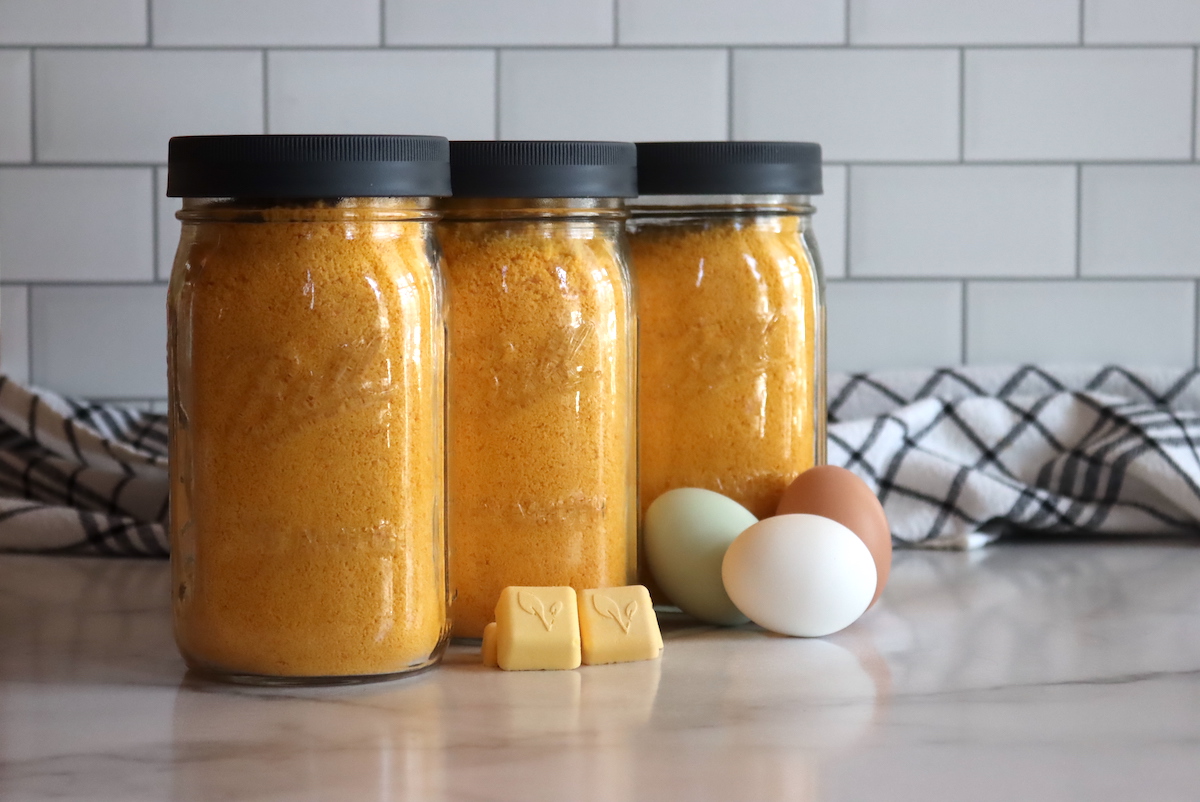
Freeze-drying eggs was one of the main reasons we bought a home freeze-dryer. Our chickens lay heavily each spring, as do most backyard flocks, but they taper off each winter… especially up here in the north country.
Short days mean we’re living on stored eggs right through both throughout holiday baking season and cold winter mornings when the whole family loves to eat scrambled eggs for breakfast each morning. Naturally, we’re always looking for more ways to preserve eggs.
We have a method for storing whole eggs in limewater in our basement, and though it does work and keeps them fresh for up to a year…it takes up a lot of space. It’s also a bit messy and cumbersome to fish out the eggs from storage when we want to use them.
Freeze-dried eggs, on the other hand, are compact to store and rehydrate easily for both cooking and baking. We tend to freeze dry raw eggs, as they’re the most versatile and they work well in all manner of recipes. You can even rehydrate them and quickly cook them into a hot fresh plate of scrambled eggs.
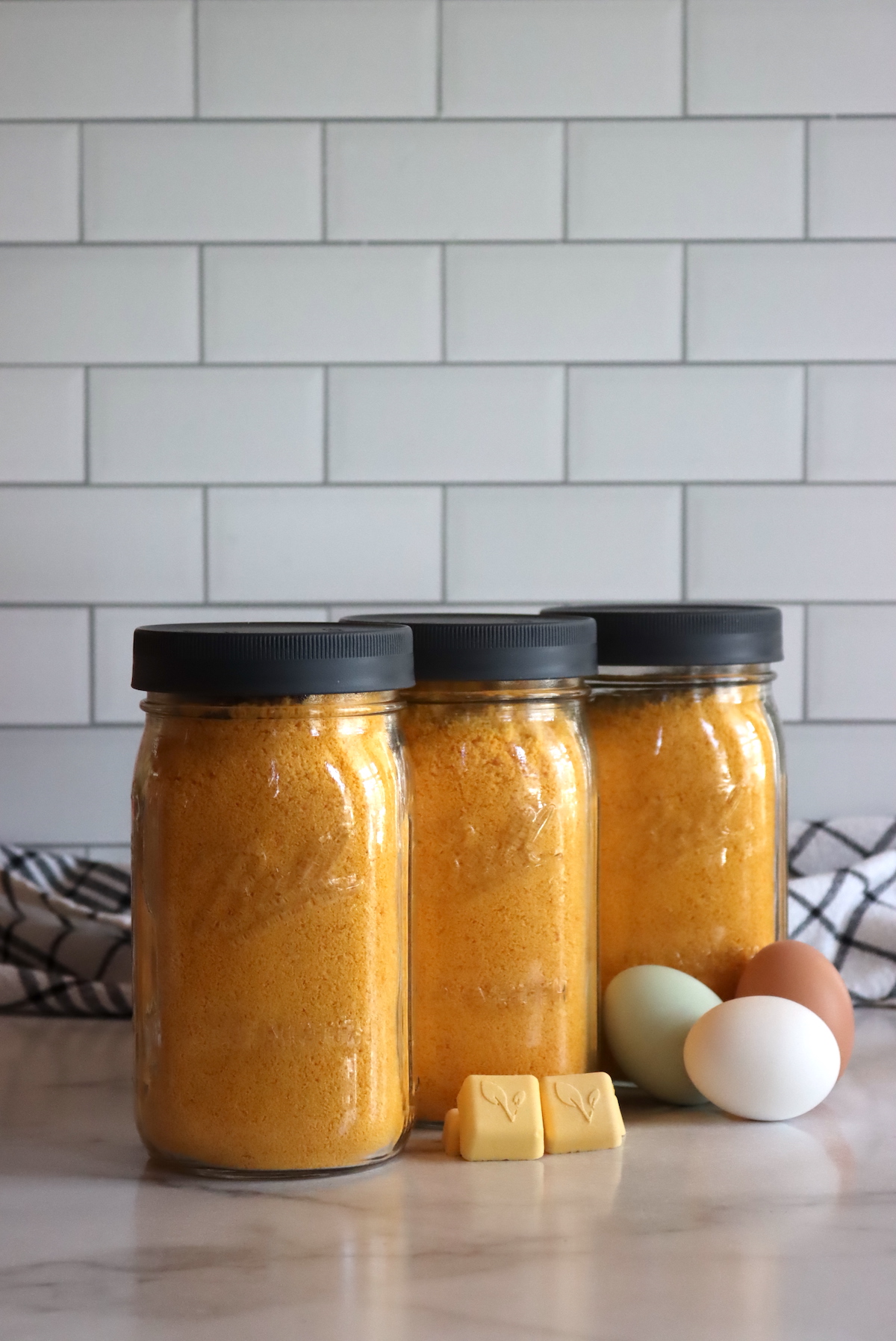
A number of food storage companies sell freeze-dried raw egg powder as a long-term storage shelf stable pantry staple, and if you’re curious to try them out (and you don’t have a freeze dryer), you can get it from Augason Farms, Emergency Essentials, Valley Food Storage or Nutrient Survival.
(I generally opt for Emergency Essentials for bulk long-term food storage items, as they tend to have the best pantry staples and ingredients.)
You can also freeze dry cooked scrambled eggs, which are popular with hikers and backpackers. They become an instant breakfast, just pour hot water over the top to rehydrate.
Mountain House actually makes a number of freeze-dried egg camping meals, including plain freeze-dried scrambled eggs with bacon, and my favorite, their breakfast skillet which has potatoes, eggs, sausage, peppers, and onions.
I’m working on a homemade mountain house breakfast skillet recipe for the freeze dryer, so check back soon for that copycat recipe.
In the meantime, I’ll walk you through how to freeze dry eggs, both raw and cooked.
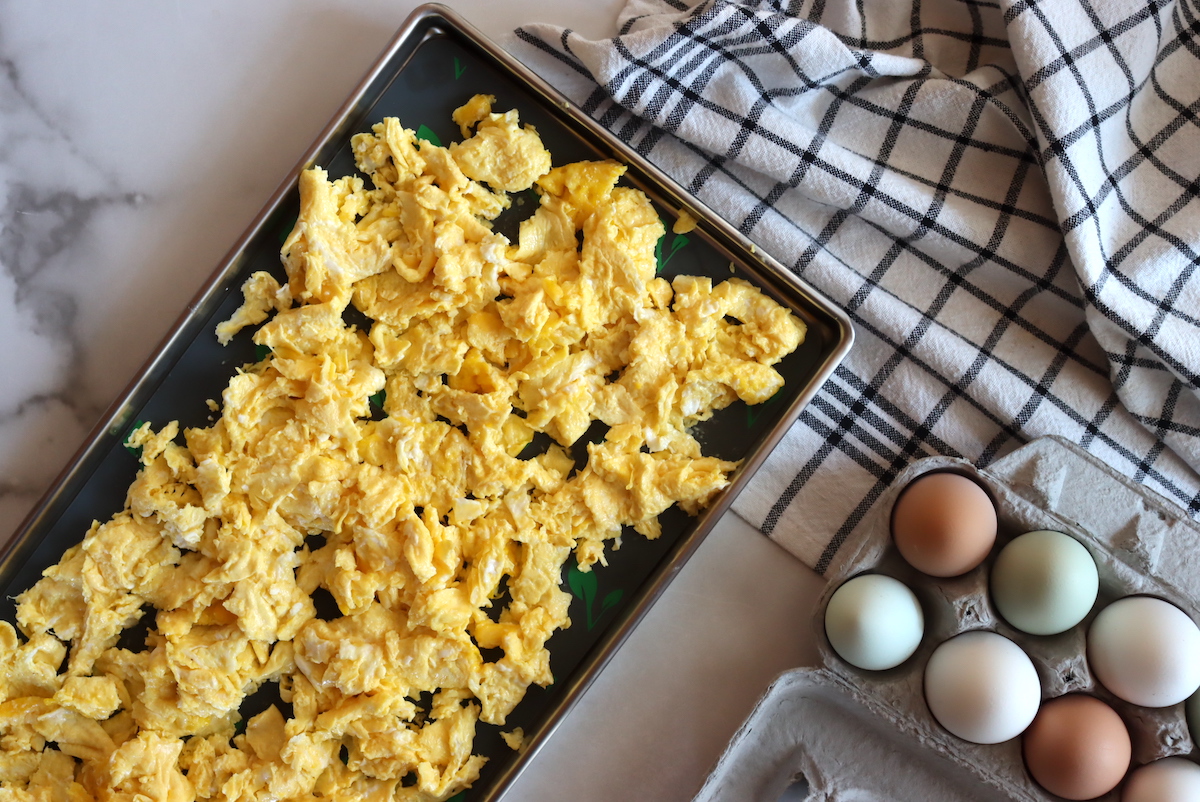
How to Freeze Dry Eggs
The basic process for freeze-drying eggs is pretty simple, as the machine more or less does everything for you. That’s one of the things I really love about home freeze dryers. Once you load the food, it’s pretty much hands-off until it’s done.
Preparing the food for freeze-drying can be a bit specific though, as it is with eggs. The eggs must be scrambled first, as freeze dryers don’t work well with anything that’s just a concentrated fat or oil source (ie. Peanut Butter, Cream, Coconut Milk, and Egg Yolk). If the egg yolks are scrambled together with the whites, however, it works just fine.
(While you can’t freeze dry just egg yolks because they have too much fat, you can freeze dry just egg whites since they’re mostly just liquid protein. I’ll walk you through that as well.)
You do need to choose whether you’re going to freeze dry raw eggs, or cooked scrambled eggs. Both work well, but they obviously have different uses. If you’re freeze-drying cooked eggs, you just cook them first and then place the freshly cooked eggs on the freeze-dryer trays. If the eggs are pre-cooked, they won’t work for baking, but they do make a fine instant breakfast.
I’ll start with freeze-drying raw eggs, as that’s the most versatile. The basic steps are as follows:
- Crack Eggs
- Scramble Eggs (not optional)
- Pre-Freeze Eggs (Optional, but Recommended)
- Insert in Freeze Dryer and Run Cycle
- Remove and Store
Start by cracking the eggs and then scrambling them.
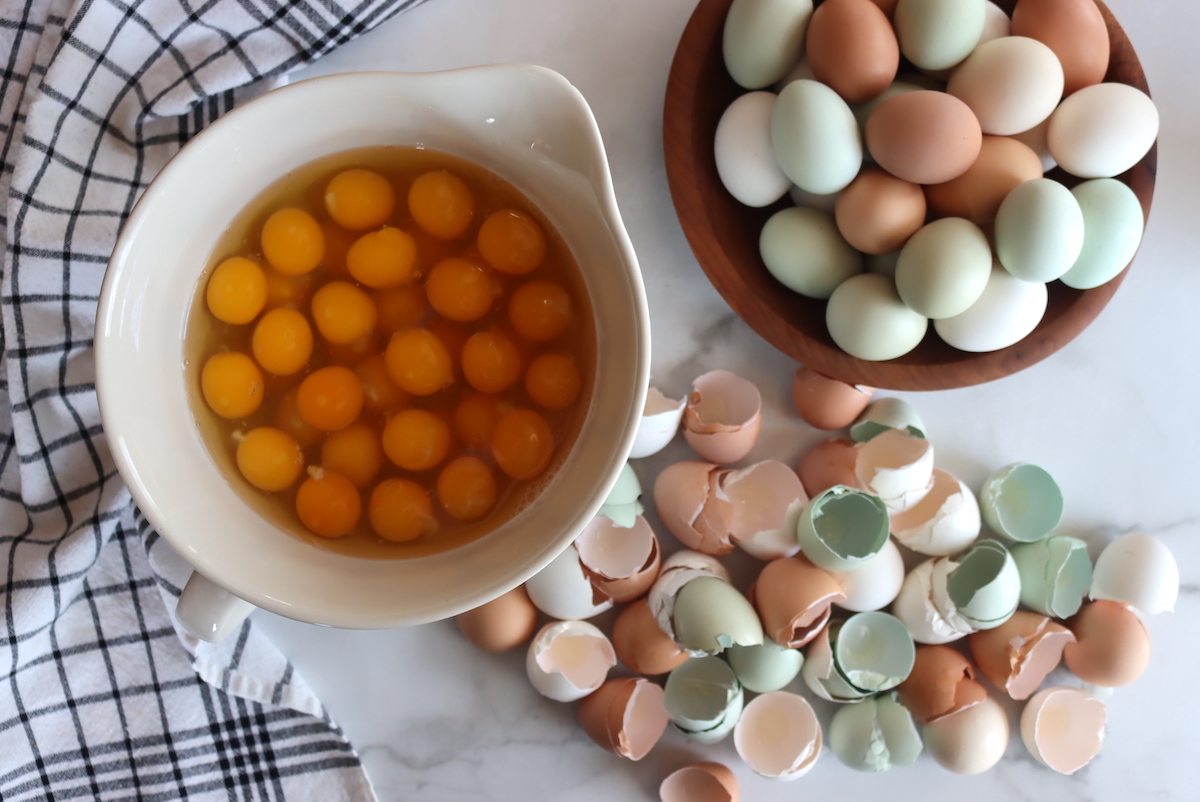
We have a large freeze dryer, and each tray can hold about 18 to 20 eggs. The machine has 5 trays, so that means a full batch is around 90 to 100 eggs.
You don’t have to run it full, but obviously, it’s more efficient to do a bit batch at once since each cycle uses the same amount of electricity, even if you’re only making half as much.
If you want to do smaller batches, you should opt to have the small freeze-dryer model which holds around 24 to 36 eggs per batch, or the medium freeze-dryer model which holds about 45 to 50 egg batches. (Conversely, if you’re looking to put up enough food to feed an army, they also have an extra large freeze dryer that does around 200 to 250 eggs at a time.)
As I mentioned, you do need to scramble the eggs thoroughly before freeze-drying, and I used an immersion blender to get them really well scrambled. (A blender works too, as does a big whisk and a lot of elbow grease.) Whatever you use, make sure they’re very well scrambled.
Next, place the raw scrambled eggs on your freeze-dryer trays. This is actually a bit trickier than you’d think, as you basically have a baking tray full of liquid…and any tipping can be problematic.
Generally, you’re supposed to pre-freeze food before you put it in the freeze dryer, and that helps speed up the process. With a tray full of liquid raw eggs, the odds that you’re going to tip that tray when you’re putting it into your freezer are pretty high.
For eggs in particular, I’d recommend just scrambling the eggs and then putting the trays into your freeze dryer most of the way. Pour the eggs into a corner of the tray and then slide the tray in the rest of the way so they don’t tip.
I actually have some nifty little silicone food mold inserts for my freeze dryer that were just released, and they’re basically a giant silicone ice cube tray. They’re handy when you’re freeze-drying liquids of all forms, including milk and eggs, but also things like ice cream and sourdough starter.
If you have these, they hold the food on the trays really nicely, and tipping is less of an issue.

If you don’t have these silicone food molds for freeze-drying, I don’t recommend using parchment or flat silicone mats for freeze-drying eggs. The silicone mats that harvest right sells for their trays are incredibly useful for fruits, meats, and whole meals in the freeze dryer…but I don’t like them for liquids.
When you pour the liquid onto the tray, it just seeps under the silicone mat and makes a big mess. The same is true for parchment.
Just pour the eggs right onto the stainless steel trays for freeze-drying if you don’t have the silicone food mold accessory.
Next, pre-freeze the food if you can do it without tipping the trays. Or, just load the trays as is into the freeze dryer.
Turn the machine on and let it run its cycle, which should take about 16 to 24 hours or so.
Once the cycle is done, you should have trays of fully freeze-dried eggs to store.
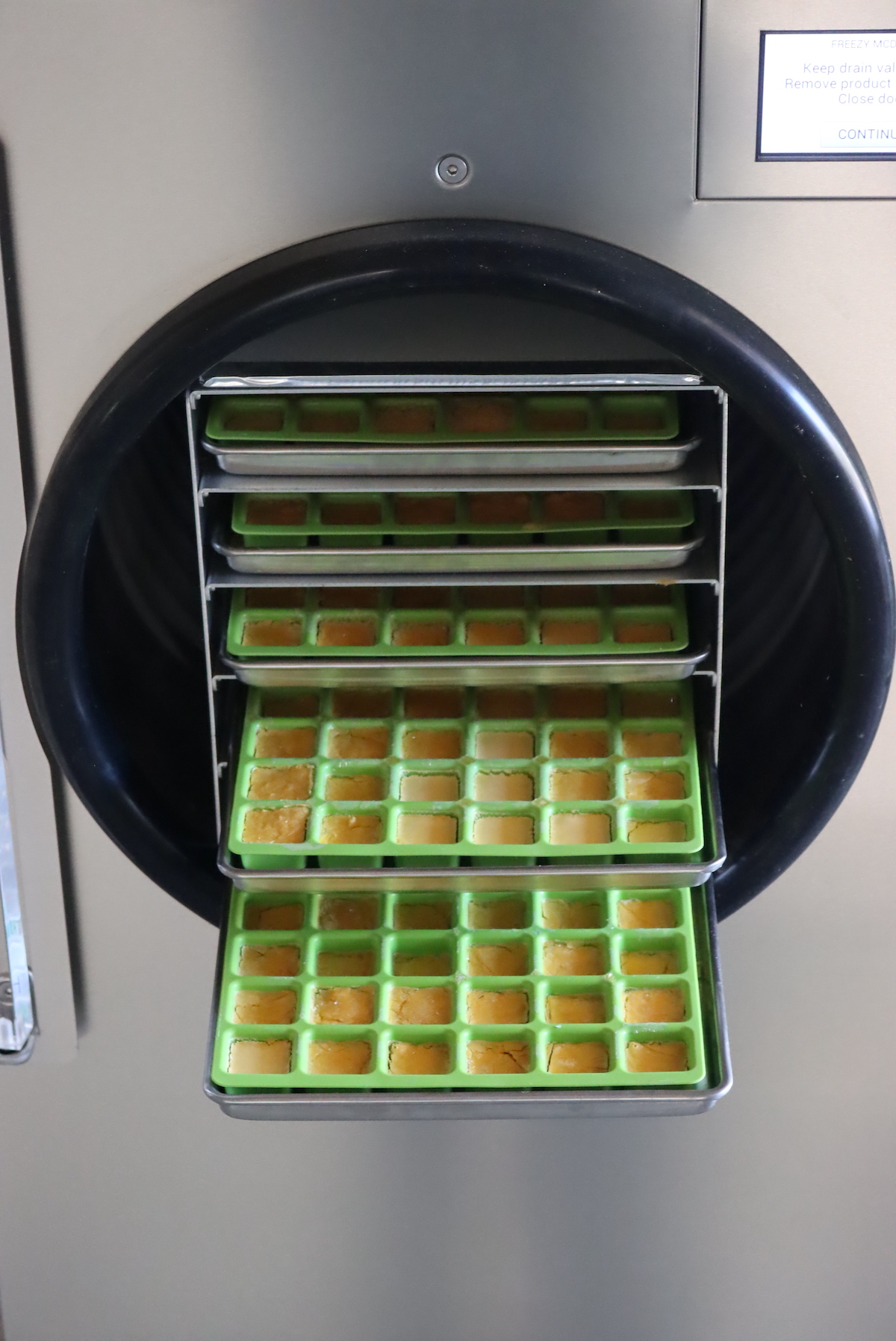
Once the cycle is complete, remove the trays from the freeze dryer and pull out the freeze-dried egg.
If you’re using plain stainless trays, that will involve scraping it up with a spatula. In the silicone food molds, each little egg cube just pops out neatly without sticking.
Neat cubes or not, it doesn’t matter, since you’ll be making egg powder either by mashing it up or putting it through a food processor. Cubes or chunks of freeze-dried raw egg don’t rehydrate well, and you really do want a powder to use.

Once your eggs are freeze-dried, you’ll want to powder them up before storage so that they’re ready to use. They’re also a lot more compact that way.
My kids went to work mashing the egg cubes up and had a grand old time, and they do fall apart really easily, so a food processor is not strictly necessary. That said, a food processor gives you a nice even powder, and it only takes a few pulses.
Freeze-Dried Egg Alternatives
While the most versatile way to freeze dry eggs is as raw whole eggs scrambled together and then powdered for later use, that’s not your only option.
Freeze Dried Scrambled Eggs (Cooked)
You can freeze dry cooked scrambled eggs, and that works just fine. They cannot be used for baking, of course, but they make a lovely camping meal breakfast. All you have to do is pour boiling water on top of them and allow them to rehydrate. You can basically make your own mountain house meals this way, and for a lot less money.
To do that, just scramble the eggs and cook them in a pan before placing them on the freeze-dryer trays. I like to scramble mine until they’re just barely done, as they’re going to get cooked ever so slightly more when you rehydrate them with boiling water. I use about a tablespoon of butter for every three eggs too, and it adds extra buttery richness (but isn’t so much that they won’t freeze dry nicely).
Since the eggs are pre-cooked, they won’t slip under parchment or silicone mats, so I use silicone mats under these to make cleanup easier.
You can fit about a dozen cooked scrambled eggs on a single large freeze-dryer tray.
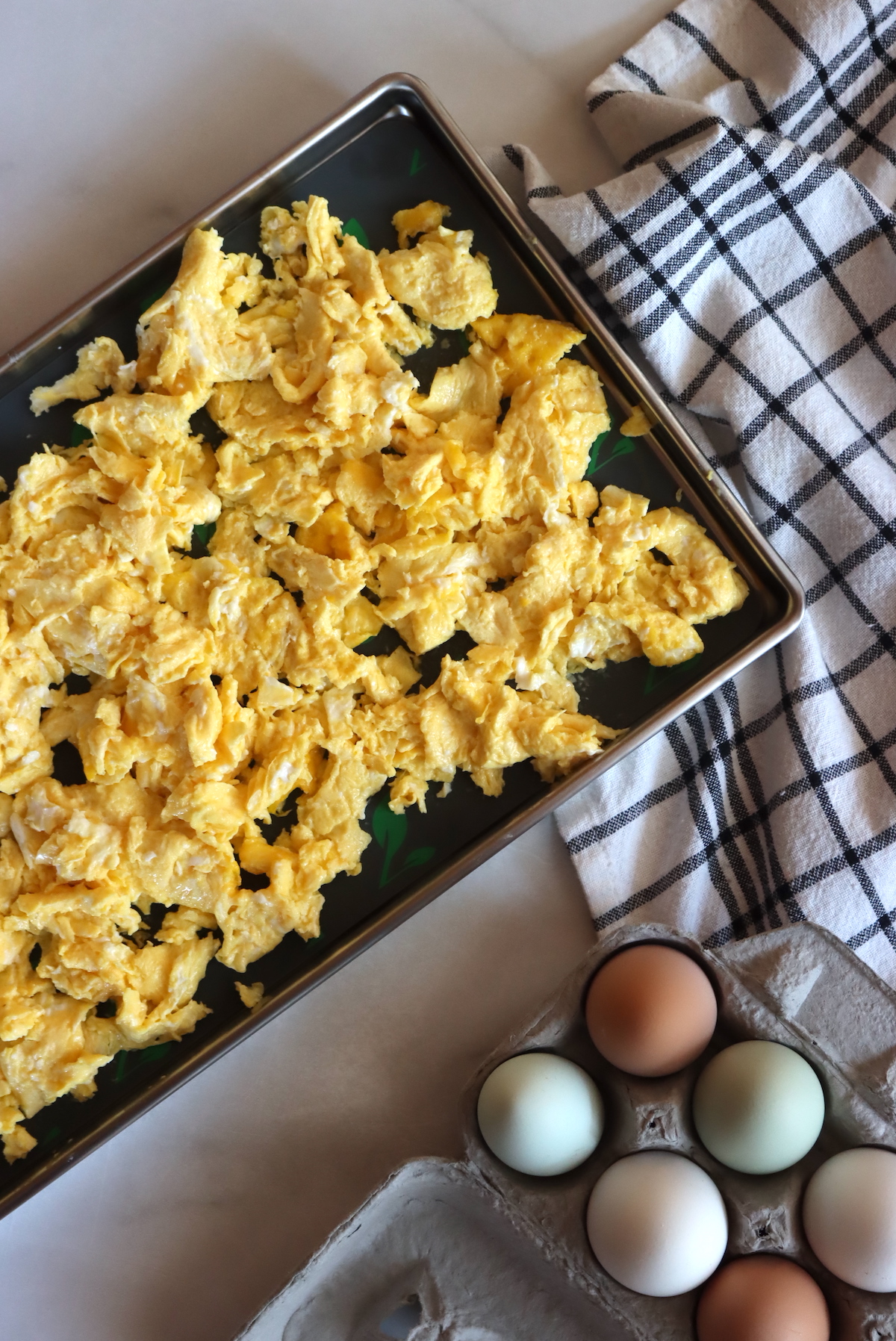
Freeze Dried Egg Whites
While you can’t freeze dry egg yolks alone because they’re too high in fat, you can freeze dry plain egg whites.
This comes in handy when making a recipe that uses a lot of egg yolks, like when making homemade pasta from scratch. The recipe uses 6 egg yolks and one whole egg.
I’ve found that I can fit about 24 egg whites onto a single large freeze-dryer tray, which means a quadruple batch of pasta. (In case you’re wondering, 24 egg yolks fit precisely into a pint mason jar, so I can get everything ready for freeze-drying and put the yolks away to make pasta the next day).

How to Store Freeze Dried Eggs
At this point, you have freeze-dried egg powder that needs to be stored in a dry, airtight container out of direct sunlight. The best way to store freeze-dried eggs is in sealed mylar pouches with oxygen absorbers. When you buy a freeze dryer, it comes with an impulse sealer that will seal mylar, as well as a starter pack of mylar pouches and oxygen absorbers that are sized to those same pouches.
It really makes the process simple.
If you’re using your own mylar pouches for storage, make sure you have oxygen absorbers that are appropriately sized to the size of the pouches you choose.
How Long Do Freeze-Dried Eggs Last?
If properly stored, freeze-dried egg powder will for up to 20 years. That means oxygen absorbers and light-eliminating packaging (like mylar).
You can also store freeze-dried eggs in glass jars, like mason jars, but they should have tight-fitting lids and be stored in a dark pantry or cabinet. Without an oxygen absorber and in a container that’s frequently opened, freeze-dried eggs should last about a year if kept clean and dry.
How to Use Freeze-Dried Eggs
To reconstitute freeze-dried eggs, mix equal parts freeze-dried egg and water by volume and allow it to sit for 5 or so minutes to fully rehydrate.
It takes 2 Tablespoons of freeze-dried egg and 2 Tablespoons of water to equal one fresh whole egg.
(Every freeze-dried food has different rehydration instructions, so if you have a freeze-dryer, I’d strongly suggest investing in the book Rehydration Calculations Made Easy which covers just about every freeze-dried or dehydrated food under the sun.)
If you’re using freeze-dried eggs in baked goods, you can make the eggs ahead of time and add them to the mix like you would use a fresh egg.
You can also add the powdered freeze-dried egg to the dry ingredients, and then just add the appropriate amount of water to the wet ingredients. That allows you to make your own powdered pantry mixes that are simple just add water mixes. Mix together things like flour, baking powder, powdered eggs, sugar, and whatever else your recipe calls for and you can design your own mixes for pancakes, muffins, and more.

Freeze Dried Eggs
Ingredients
- Whole Fresh Eggs
Instructions
- Start by cracking and scrambling the eggs. Be sure that the eggs are thoroughly scrambled. A blender or immersion blender helps.
- Pre-chill your freeze dryer and close the air vent at the back.
- Insert the freeze dryer trays about 3/4 of the way into the freeze dryer, and then carefully pour the raw egg onto the tray. (This prevents the tray from tipping, resulting in spilled eggs. If you have silicone insert molds for your freeze dryer trays, as I do, you can fill those and pre-freeze them. Do not attempt to pre-freeze the eggs or other liquids directly on the trays, as they'll likely spill as they're moved around.)
- Press start on the freeze dryer, and it will begin the cycle, first freezing the food, then creating a vacuum, and then finally freeze-drying the eggs.
- When the cycle is complete, remove the eggs from the freeze dryer for storage.
- Crushing the eggs into a powder before storage is optional, but recommended. They'll pack tighter into bags that way, and they rehydrate better if first crushed into a powder (rather than left as chunks).
- For short-term storage, store in an air-tight container such as a mason jar. For long-term storage, use mylar bags with oxygen absorbers.
Notes
Yield
We have a large freeze dryer, and each tray can hold about 18 to 20 eggs. The machine has 5 trays, so that means a full batch is around 90 to 100 eggs. My total yield was 3 quarts of freeze-dried egg powder. Yield will vary based on the size of your freeze dryer.- Small Model - 24 to 36 eggs
- Medium Model - 45 to 50 eggs
- Large Model - 90 to 100 eggs
- Extra Large Model - 200 to 250 eggs
Freeze Dried Scrambled Eggs (Cooked)
You can freeze dry cooked scrambled eggs, and that works just fine. They cannot be used for baking, of course, but they make a lovely camping meal breakfast. All you have to do is pour boiling water on top of them and allow them to rehydrate. You can basically make your own mountain house meals this way, and for a lot less money. To do that, just scramble the eggs and cook them in a pan before placing them on the freeze-dryer trays. I like to scramble mine until they're just barely done, as they're going to get cooked ever so slightly more when you rehydrate them with boiling water. I use about a tablespoon of butter for every three eggs too, and it adds extra buttery richness (but isn't so much that they won't freeze dry nicely). Since the eggs are pre-cooked, they won't slip under parchment or silicone mats, so I use silicone mats under these to make cleanup easier. You can fit about a dozen cooked scrambled eggs on a single large freeze-dryer tray.Freeze Dried Eggs FAQ
Hopefully, at this point, I’ve covered everything you could possibly want to know about freeze-dried eggs, as well as both how to make and use them.
If you still have questions, the FAQ below covers a few more of the finer points. If I’ve missed something, please do ask in the comments.
Can You Freeze Dry Raw Eggs?
Yes, you can freeze dry raw eggs. Freeze-drying raw eggs is actually the most versatile way to preserve eggs, rather than cooked.
When eggs are freeze-dried raw, they can be rehydrated and cooked, or used in baked goods.
Are Freeze Dried Eggs Pasteurized or Sterile?
No, freeze-dried eggs are not pasteurized in any way, unless you’re using pasteurized eggs to start with.
The freeze-drying process doesn’t kill bacteria, it only hits “pause” on spoilage and removes water so that the food doesn’t spoil or degrade in storage.
Once rehydrated, the eggs will need to be cooked fully before consumption, or kept in the refrigerator. They’re basically the same as any fresh egg at that point.
Can you Freeze Dry Eggs Without a Freeze Dryer?
No. Unfortunately, you really need a freeze dryer to successfully make freeze-dried eggs. I do cover other methods for freeze-drying food at home, but none of them are practical in the slightest (and most simply don’t work at all).
How much freeze-dried egg equals a fresh egg?
To rehydrate freeze-dried egg powder into the equivalent of one fresh egg, mix 2 Tbsp. of powder with 2 Tbsp. of cool water.
Whisk gently until it’s well combined, and allow it to rehydrate for about 5 minutes before using.
How Many Eggs Fit in a Freeze Dryer?
We have the harvest right large freeze dryer with 5 trays. Each tray will hold about 18 to 20 eggs, so a full batch of freeze-dried eggs in a large freeze-dryer is about 90 to 100 eggs.
I’m using the silicone tray inserts that harvest right sells for liquids, and they work really well to keep everything contained. (It’s really hard to pre-freeze eggs in trays if they’re just in the tray lose, as any tipping will result in spilled eggs in the freezer. The silicone trays keep everything neat and contained, even if they’re not kept perfectly level as you get them into the freezer.)
If you have a medium freeze dryer, each tray will hold about a dozen eggs, and those units have 4 trays. A medium freeze dryer can process about 45 to 50 eggs per cycle.
Harvest right now sells an extra large freeze dryer, which can hold 200 to 250 eggs, or enough to feed an army.
They also have a small freeze dryer that does 24 to 36 eggs in a batch.
Freeze Drying Guides
Looking for more freeze-drying tutorials?
- How to Freeze Dry Food at Home
- Best (and Worst) Freeze Dried Food for Long Term Storage
- Cooking with Freeze Dried Meat
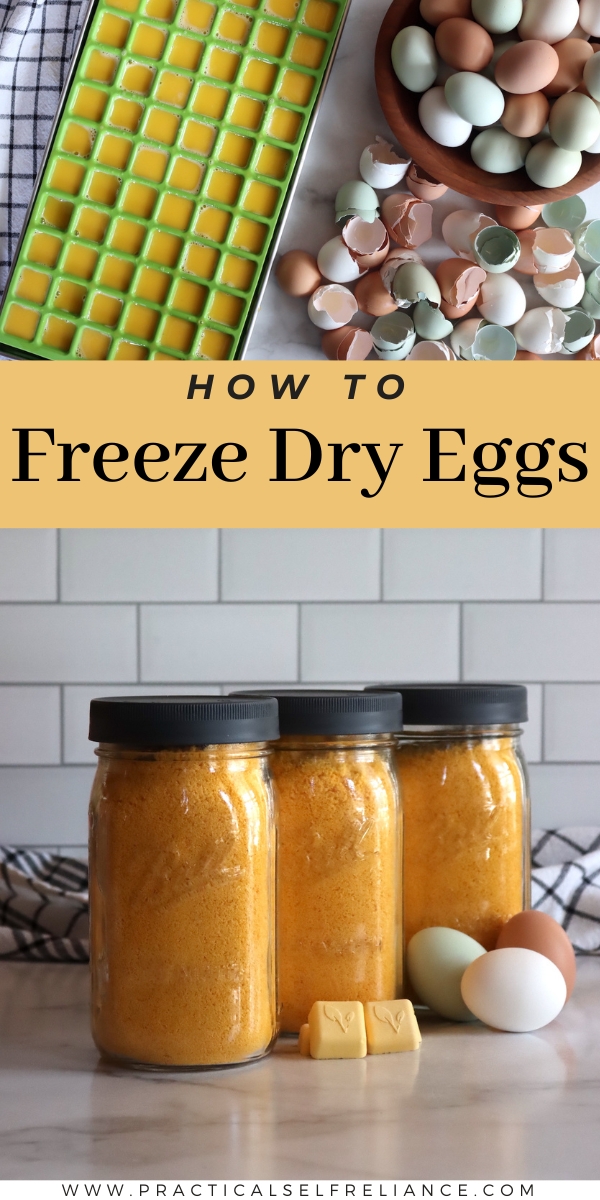
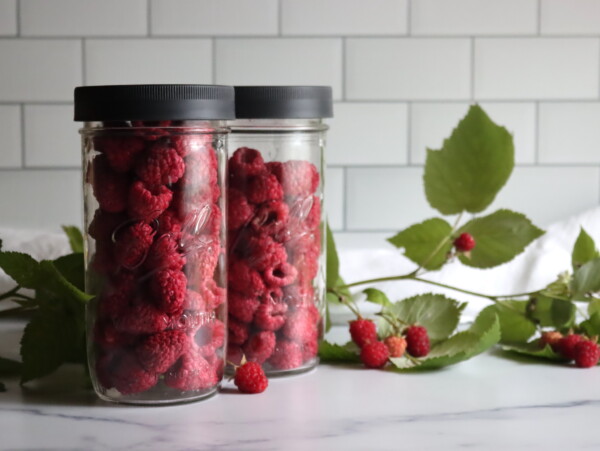
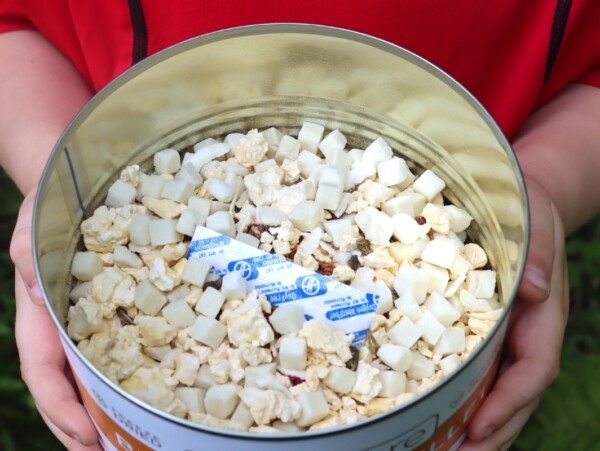
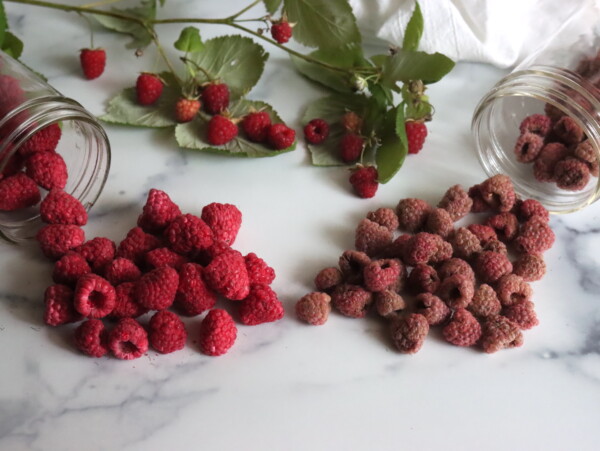
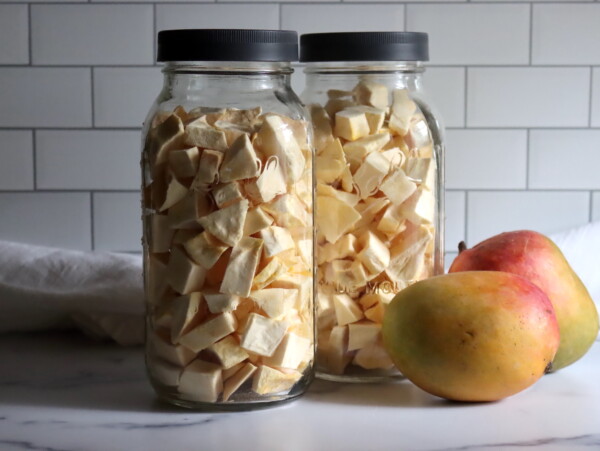










At what temperature are raw eggs freeze dried? I want to use the freeze dried eggs for baking.
You just use the standard settings on your freeze dryer.
I boiled the eggs. I ran them all through the food processor, put them on a food dehydrator, then ran them through the food processor again. It didn’t work very well. They are still in quart jars and still dry, but it won’t turn into an egg when water is added. The eggs are still preserved, but I’ve got to figure out what else I can use them for. Perhaps a filler for other foods? The way I look at it, I’m still preserving the eggs in some manner. I just have to figure out how to use them.
It’s typically not recommended that you use a food dehydrator for drying eggs as there is an increased risk of salmonella. The freeze dryer is much more effective and producers a better result in the end.
I completed my first batch of freeze dried eggs. I reconstituted with 2 tablespoons powder and 2 tablespoons water. The result seems very runny/liquidy compared to videos I’ve seen, where it looks thick like a freshly cracked eggs.
When I cooked it, the result was a very thin piece of cooked egg. The taste was okay. Just wondering if I need to change something.
Thanks for taking your time to give feedback.
I would just adjust the water amount to get it to the thickness that you desire.
I never have enough eggs to do a whole batch of eggs in the freeze dryer. What would you recommend freezing at the same time? If I use the eggs for baking, I don’t want them to taste like whatever I put in the freeze dryer on other trays like onions or peppers. Thanks!
Also have you ever freeze dried precooked beans?
Good question! So a couple of things to consider here…
-Eggs are high moisture, so they take a while to freeze dry. If you combine batches, choose things that also are high moisture, because even if they freeze dry faster, they’ll still be in there until he eggs are done.
-Obviously, smell transfer as you mention is a big issue.
The best choice I’d say would be milk, as it’s also high moisture but without a smell. Other than that, things like fruits would be a good choice too, as most have very little smell transfer potential.
I haven’t freeze dried pre-cooked beans (yet) as those do so well canned (https://practicalselfreliance.com/canning-beans/) but it would be nice to have an instant version for camping. I’ll give those a try soon!
I’ve grown my own stevia and turned it into powder and it’s definitely sweet but tastes like a green plant. How do you get rid if that ‘green’ taste? It definitely ruins coffee.
Can you explain the exact process that you used to turn it into powder?